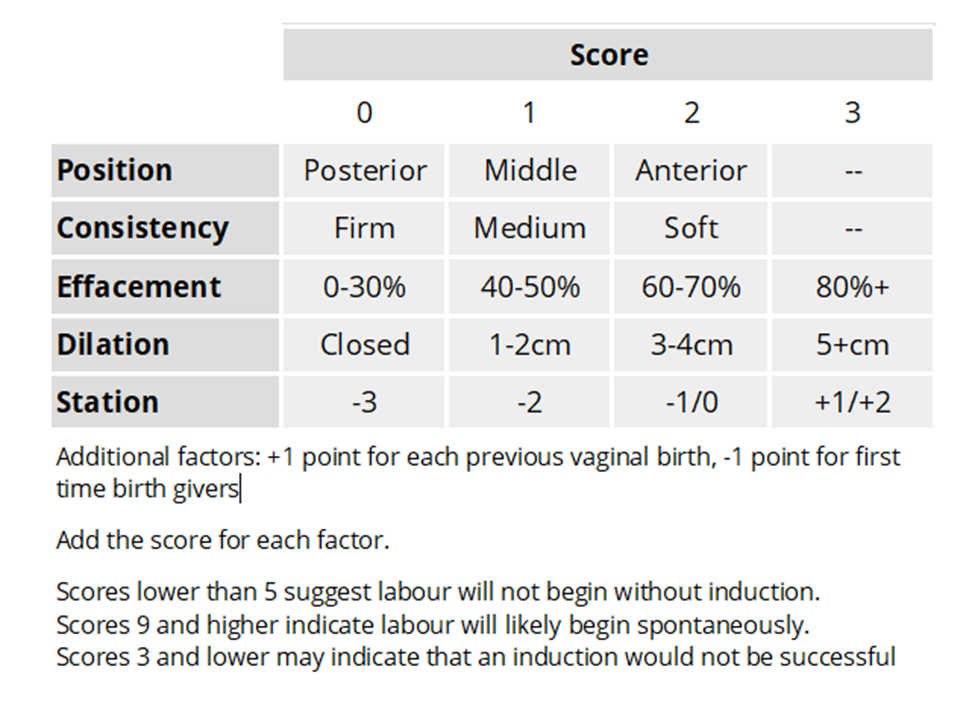A nurse is caring for a client who is scheduled to receive intravenous oxytocin for the induction of labor. The client has a Bishop score of 8 which of the following findings should the nurse expect?
The client will require a vacuum- or forceps-assisted delivery.
The client will experience a successful induction of labour
The client will experience lower back pain during labor.
The client will require dinoprostone for ripening of the cervix.
The Correct Answer is B
The correct answer is B. The client will experience a successful induction of labor.
A. The Bishop score is a pre-induction assessment that evaluates several factors, including cervical dilation, effacement, consistency, position, and fetal station. It is used to predict the likelihood of a successful induction of labor. A high Bishop score indicates favorable conditions for induction.
B. Correct. A higher Bishop score indicates a more favorable cervix for induction, and the chances of a successful induction of labor are increased.

C. Lower back pain during labor is not specifically associated with the Bishop score. It can be a common complaint during labor, but it is not predicted by the Bishop score.
D. Dinoprostone is a prostaglandin used for cervical ripening. If the Bishop score indicates an unfavorable cervix, dinoprostone or other cervical ripening agents may be considered to prepare the cervix for induction.
Nursing Test Bank
Naxlex Comprehensive Predictor Exams
Related Questions
Correct Answer is A
Explanation
The correct answer is A. Monitor the fetal heart rate (FHR) every hour.
A. Monitoring the fetal heart rate every hour is a crucial aspect of the plan of care during active labor. Continuous fetal monitoring helps assess the well-being of the baby and ensures timely identification of any signs of fetal distress.
B. Inserting an indwelling urinary catheter is not a routine intervention during active labor. The bladder can be monitored using other non-invasive methods, and catheterization is generally reserved for specific indications.
C. Keeping four side rails up while the client is in bed is not recommended. It may limit the client's mobility and is not a standard practice during labor. Ensuring the safety of the client and promoting mobility is important.
D. Checking the cervix prior to analgesic administration may be necessary, but it is not a general action for every client in active labor. The need for cervical checks should be individualized based on the client's progress, preferences, and clinical indications.
Correct Answer is D
Explanation
Choice A Reason:
"The nurse will carry your newborn to the nursery for procedures. "This statement is inappropriate. In current practice, there is an emphasis on family-centered care, and parents are often encouraged to be involved in the care of their newborns, including accompanying them for procedures whenever possible.
Choice B Reason:
"We will document the relationship of visitors in your medical record." This statement is inappropriate. While it is important to monitor and document visitors, the primary focus here is on healthcare staff and their identification.
Choice C Reason:
"Your baby will stay in the nursery while you are asleep." This statement is inappropriate. Promoting rooming-in and encouraging parental involvement in newborn care is a common practice to support bonding and breastfeeding, so this statement may not align with current best practices.
Choice D Reason:
"Staff members who take care of your baby will be wearing a photo identification badge." This statement reassures the client that the healthcare providers involved in the care of the newborn will have proper identification, enhancing security and ensuring that authorized personnel are handling the infant.
Whether you are a student looking to ace your exams or a practicing nurse seeking to enhance your expertise , our nursing education contents will empower you with the confidence and competence to make a difference in the lives of patients and become a respected leader in the healthcare field.
Visit Naxlex, invest in your future and unlock endless possibilities with our unparalleled nursing education contents today
Report Wrong Answer on the Current Question
Do you disagree with the answer? If yes, what is your expected answer? Explain.
Kindly be descriptive with the issue you are facing.
